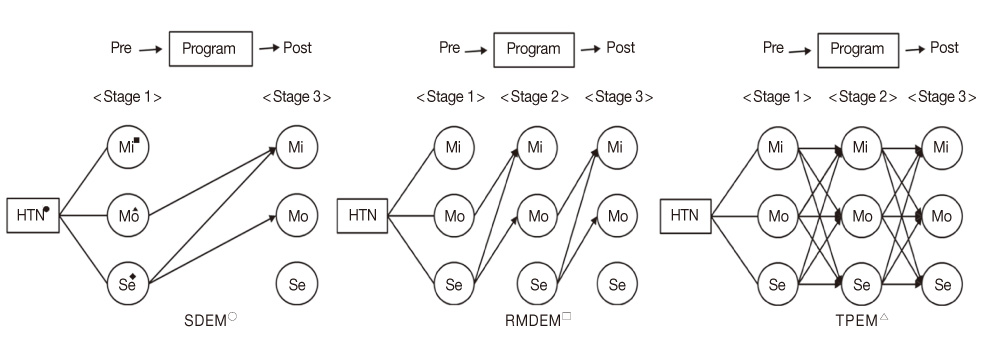J Korean Acad Nurs.
2011 Dec;41(6):750-757. 10.4040/jkan.2011.41.6.750.
Comparison of Benefit Estimation Models in Cost-Benefit Analysis: A Case of Chronic Hypertension Management Programs
- Affiliations
-
- 1Department of Nursing, Inha University, Incheon, Korea. lim20712@inha.ac.kr
- 2College of Nursing, University of Illinois at Chicago, Chicago, U.S.A.
- 3Women's Policy Division, Incheon Metropolitan City Hall, Incheon, Korea.
- KMID: 1120107
- DOI: http://doi.org/10.4040/jkan.2011.41.6.750
Abstract
- PURPOSE
Cost-benefit analysis is one of the most commonly used economic evaluation methods, which helps to inform the economic value of a program to decision makers. However, the selection of a correct benefit estimation method remains critical for accurate cost-benefit analysis. This paper compared benefit estimations among three different benefit estimation models.
METHODS
Data from community-based chronic hypertension management programs in a city in South Korea were used. Three different benefit estimation methods were compared. The first was a standard deterministic estimation model; second, a repeated-measures deterministic estimation model; and third, a transitional probability estimation model.
RESULTS
The estimated net benefit of the three different methods were $1,273.01, $-3,749.42, and $-5,122.55 respectively.
CONCLUSION
The transitional probability estimation model showed the most correct and realistic benefit estimation, as it traced possible paths of changing status between time points and it accounted for both positive and negative benefits.
MeSH Terms
Figure
Reference
-
1. Ahmed F, Elbasha EE, Thompson BL, Harris JR, Sneller V. Cost-benefit analysis of a new HEDIS performance measure for pneumococcal vaccination. Medical Decision Making. 2002. 22(5):S58–S66. doi: 10.1177/027298902237711.2. Ahn YO. The strategy of enhancing effectiveness of health examination. 1995. Seoul: National Health Insurance Corporation.3. Alcocer L, Cueto L. Hypertension, a health economics perspective. Therapeutic Advances in Cardiovascular Disease. 2008. 2:147–155. doi: 10.1177/1753944708090572.4. Chin MH, Zhang JX, Rathouz PJ. Transitions in health status in older patients with heart failure. Southern Medical Journal. 2003. 96:1096–1106.5. Diehr P, Patrick DL. Probabilities of transition among health states for older adults. Quality of Life Research. 2001. 10:431–442.6. Korea Centers for Disease Control & Prevention. Community-based hypertension and diabetes management model development for improving adherence and compliance. 2007. 05. Seoul: Author.7. Lim J. The cost-benefit analysis of newly married couple health care program. 2008. Daejeon: Chungnam National University;Unpublished doctoral dissertation.8. Lim JY, Im JN, Kim IA, Ko S. An evaluation of effects on hypertension and diabetes mellitus management of a community-based nursing care center using cost-benefit analysis. Journal of Korean Academy of Nursing Administration. 2010. 16:295–305.9. Newhouse RP. De we know how much the evidence-based intervention cost? The Journal of Nursing Administration. 2010. 40:296–299. doi: 10.1097/NNA.0b013e3181e93760.10. Pappas SH. The cost of nurse-sensitive adverse events. The Journal of Nursing Administration. 2008. 38:230–236. doi: 10.1097/01.NNA.0000312770.19481.ce.11. Peng R, Ling L, He Q. Self-rated health status transition and long-term care need. Health Policy. 2010. 97:259–266. doi: 10.1016/j.healthpol.2010.05.009.12. Romo R, Gifford L. A cost-benefit analysis of music therapy in a home hospice. Nursing Economics. 2007. 25:353–358.13. Stephens S. Hospital-based palliative care: Cost-effective care for patients with advanced disease. The Journal of Nursing Administration. 2008. 38:143–145. doi: 10.1097/01.NNA.0000310724.20419.12.14. Stevens B, Guerriere D, McKeever P, Croxford R, Miller KL, Watson-MacDonell J, et al. Economics of home vs. hospital breastfeeding support for newborns. Journal of Advanced Nursing. 2006. 53:233–243.15. Yim ES. Cost-benefit analysis of the case management for the elderly patients with hypertension. 2008. Seoul: Yonsei University;Unpublished doctoral dissertation.
- Full Text Links
- Actions
-
Cited
- CITED
-
- Close
- Share
- Similar articles
-
- Cost-Benefit Analysis of a Factory Dispensary
- An Evaluation of Effects on Hypertension and Diabetes Mellitus Management of a Community-Based Nursing Care Center Using Cost-Benefit Analysis
- Cost-benefit Analysis of Home Visiting Care for Vulnerable Populations with Hypertension
- An Economic Evaluation of the Home Nursing Care Services: Public Health Center Versus Private Hospital
- Economic evaluation of environmental epidemiological projects in national industrial complexes


